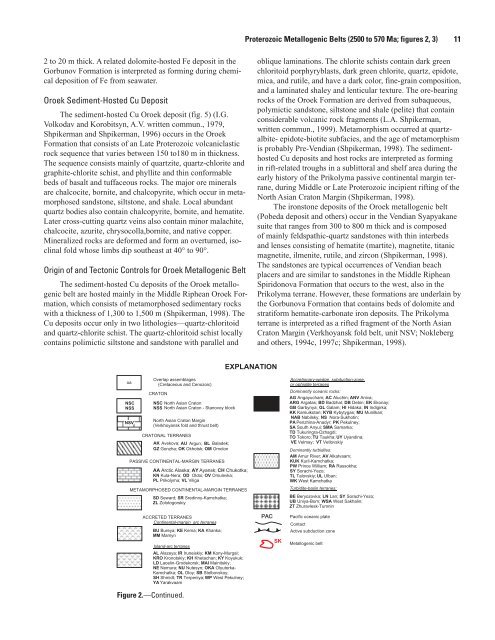USGS Professional Paper 1697 - Alaska Resources Library
USGS Professional Paper 1697 - Alaska Resources Library
USGS Professional Paper 1697 - Alaska Resources Library
Create successful ePaper yourself
Turn your PDF publications into a flip-book with our unique Google optimized e-Paper software.
2 to 20 m thick. A related dolomite-hosted Fe deposit in the<br />
Gorbunov Formation is interpreted as forming during chemical<br />
deposition of Fe from seawater.<br />
Oroek Sediment-Hosted Cu Deposit<br />
The sediment-hosted Cu Oroek deposit (fig. 5) (I.G.<br />
Volkodav and Korobitsyn, A.V. written commun., 1979,<br />
Shpikerman and Shpikerman, 1996) occurs in the Oroek<br />
Formation that consists of an Late Proterozoic volcaniclastic<br />
rock sequence that varies between 150 to180 m in thickness.<br />
The sequence consists mainly of quartzite, quartz-chlorite and<br />
graphite-chlorite schist, and phyllite and thin conformable<br />
beds of basalt and tuffaceous rocks. The major ore minerals<br />
are chalcocite, bornite, and chalcopyrite, which occur in metamorphosed<br />
sandstone, siltstone, and shale. Local abundant<br />
quartz bodies also contain chalcopyrite, bornite, and hematite.<br />
Later cross-cutting quartz veins also contain minor malachite,<br />
chalcocite, azurite, chrysocolla,bornite, and native copper.<br />
Mineralized rocks are deformed and form an overturned, isoclinal<br />
fold whose limbs dip southeast at 40° to 90°.<br />
Origin of and Tectonic Controls for Oroek Metallogenic Belt<br />
The sediment-hosted Cu deposits of the Oroek metallogenic<br />
belt are hosted mainly in the Middle Riphean Oroek Formation,<br />
which consists of metamorphosed sedimentary rocks<br />
with a thickness of 1,300 to 1,500 m (Shpikerman, 1998). The<br />
Cu deposits occur only in two lithologies—quartz-chloritoid<br />
and quartz-chlorite schist. The quartz-chloritoid schist locally<br />
contains polimictic siltstone and sandstone with parallel and<br />
oa<br />
Overlap assemblages<br />
(Cretaceous and Cenozoic)<br />
NSC NSC North Asian Craton<br />
NSS NSS North Asian Craton - Stanovoy block<br />
NSV<br />
CRATON<br />
North Asian Craton Margin<br />
(Verkhoyansk fold and thrust belt)<br />
CRATONAL TERRANES<br />
AK Avekova; AU Argun; BL Baladek;<br />
GZ Gonzha; OK Okhotsk; OM Omolon<br />
PASSIVE CONTINENTAL-MARGIN TERRANES<br />
AA Arctic <strong>Alaska</strong>; AY Ayansk; CH Chukotka;<br />
KN Kula-Nera; OD Oldoi; OV Omulevka;<br />
PL Prikolyma; VL Viliga<br />
METAMORPHOSED CONTINENTAL-MARGIN TERRANES<br />
SD Seward; SR Sredinny-Kamchatka;<br />
ZL Zolotogorskiy<br />
ACCRETED TERRANES<br />
Continental-margin arc terranes<br />
BU Bureya; KE Kema; KA Khanka;<br />
MM Mamyn<br />
Island-arc terranes<br />
Figure 2.—Continued.<br />
AL Alazeya; IR Iruneiskiy; KM Kony-Murgal;<br />
KRO Kronotskiy; KH Khetachan; KY Koyukuk;<br />
LD Laoelin-Grodekorsk; MAI Mainitskiy;<br />
NE Nemura; NU Nutesyn; OKA Olyutorka-<br />
Kamchatka; OL Oloy; SB Stolbovskoy;<br />
SH Shmidt; TR Terpeniya; WP West Pekulney;<br />
YA Yarakvaam<br />
Proterozoic Metallogenic Belts (2500 to 570 Ma; figures 2, 3) 11<br />
EXPLANATION<br />
oblique laminations. The chlorite schists contain dark green<br />
chloritoid porphyryblasts, dark green chlorite, quartz, epidote,<br />
mica, and rutile, and have a dark color, fine-grain composition,<br />
and a laminated shaley and lenticular texture. The ore-bearing<br />
rocks of the Oroek Formation are derived from subaqueous,<br />
polymictic sandstone, siltstone and shale (pelite) that contain<br />
considerable volcanic rock fragments (L.A. Shpikerman,<br />
written commun., 1999). Metamorphism occurred at quartzalbite-<br />
epidote-biotite subfacies, and the age of metamorphism<br />
is probably Pre-Vendian (Shpikerman, 1998). The sedimenthosted<br />
Cu deposits and host rocks are interpreted as forming<br />
in rift-related troughs in a sublittoral and shelf area during the<br />
early history of the Prikolyma passive continental margin terrane,<br />
during Middle or Late Proterozoic incipient rifting of the<br />
North Asian Craton Margin (Shpikerman, 1998).<br />
The ironstone deposits of the Oroek metallogenic belt<br />
(Pobeda deposit and others) occur in the Vendian Syapyakane<br />
suite that ranges from 300 to 800 m thick and is composed<br />
of mainly feldspathic-quartz sandstones with thin interbeds<br />
and lenses consisting of hematite (martite), magnetite, titanic<br />
magnetite, ilmenite, rutile, and zircon (Shpikerman, 1998).<br />
The sandstones are typical occurrences of Vendian beach<br />
placers and are similar to sandstones in the Middle Riphean<br />
Spiridonova Formation that occurs to the west, also in the<br />
Prikolyma terrane. However, these formations are underlain by<br />
the Gorbunova Formation that contains beds of dolomite and<br />
stratiform hematite-carbonate iron deposits. The Prikolyma<br />
terrane is interpreted as a rifted fragment of the North Asian<br />
Craton Margin (Verkhoyansk fold belt, unit NSV; Nokleberg<br />
and others, 1994c, 1997c; Shpikerman, 1998).<br />
Accretionary-wedge, subduction-zone,<br />
or ophiolite terranes<br />
Dominantly oceanic rocks:<br />
AG Angayucham; AC Aluchin; ANV Aniva;<br />
ARG Argatas; BD Badzhal; DB Debin; EK Ekonay;<br />
GB Garbynya; GL Galam; HI Hidaka; IN Indigirka;<br />
KK Kamuikotan; KYB Kybytygas; MU Munilkan;<br />
NAB Nabilsky; NS Nora-Sukhotin;<br />
PA Penzhina-Anadyr; PK Pekulney;<br />
SA South Anyui; SMA Samarka;<br />
TD Tukuringra-Dzhagdi;<br />
TO Tokoro; TU Taukha; UY Uyandina;<br />
VE Velmay; VT Vetlovskiy<br />
Dominantly turbidites:<br />
AM Amur River; AV Alkatvaam;<br />
KUK Kuril-Kamchatka;<br />
PW Prince William; RA Rassokha;<br />
SY Sorachi-Yezo;<br />
TL Talovskiy; UL Ulban;<br />
WK West Kamchatka<br />
Turbidite-basin terranes:<br />
BE Beryozovka; LN Lan; SY Sorachi-Yezo;<br />
UB Uniya-Bom; WSA West Sakhalin;<br />
ZT Zhuravlesk-Tumnin<br />
PAC Pacific oceanic plate<br />
SK<br />
Contact<br />
Active subduction zone<br />
Metallogenic belt
















